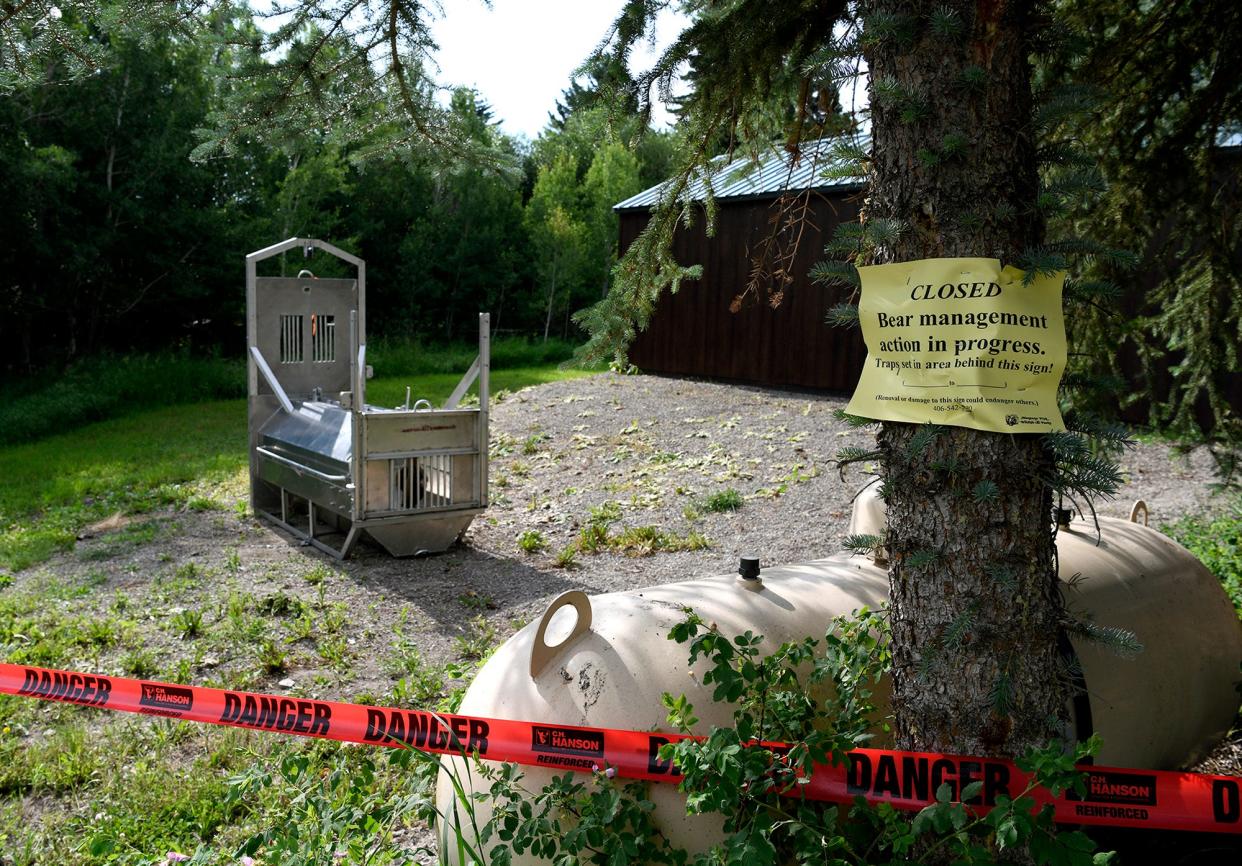48-year-old Kansas woman confirmed as the victim in Montana grizzly bear attack

The victim of the fatal grizzly bear mauling on a popular trail system west of the town of West Yellowstone last Saturday was a 48-year-old woman from Kansas, the Gallatin County Sheriff’s Office announced, and efforts to trap the bear will cease on Tuesday.
Amie Adamson, of Derby, Kansas, was likely hiking or running on the trail in the early morning, according to a news release. The sheriff's office said the bear attack "did not appear to be predatory," and the manner was accidental.
Adamson’s body was found by a hiker early Saturday morning on the Buttermilk Trail about eight miles west of West Yellowstone. According to a Montana Fish, Wildlife and Parks news release, FWP wardens and bear specialists determined that Adamson’s wounds were consistent with a bear attack. They also found tracks from an adult grizzly bear and at least one cub near the site.
"The hiker was believed to be alone during the encounter, and no bear spray or firearms were found at the scene,” an FWP news release states.
The attack occurred near an area with a high concentration of vacation lodges, rental cabins, private residences and campgrounds. In response, the Custer/Gallatin National Forest implemented an emergency closure of the area as a safety precaution and implemented efforts identify and trap the responsible bear.
According to Morgan Jacobson, media contact for FWP Region 3, wildlife officials have neither seen an aggressive bear nor captured a bear in the Buttermilk Trail System closure area, and efforts to trap the grizzly that killed Adamson will be discontinued.
“The reason that we attempted to capture this bear was because this incident took place so close to campgrounds and residences and on a trail system that sees a high volume of use and visitation,” Jacobson said. “If this happened to be a bear that was habituated to being in places like that, getting access to unsecured garbage and such it would have caused a public safety risk. That was the reason for that capture effort.
“Since we haven’t seen a bear since then and we haven’t captured one this bear may have just moved on, which is normal. This area is a travel corridor for a lot of wildlife including bears. So far, we haven’t seen a bear that has kind of stuck around and shown behavior that would indicate that it’s habituated to being near people. That’s a good thing.”
Jacobson added that wildlife officials were able to collect a single hair sample from a grizzly in the immediate area of the attack, which has been sent off for genetic analysis. The Buttermilk Trail System will remain closed to the public for an undetermined period of time.
“Even though we’re going to be shutting down trapping operations we’ll still be monitoring this area for bear activity,” he said, “and the closure will remain in effect for the time being. When the closure is lifted will be the decision of the Custer/Gallatin National Forest.”
Jacobson said that continued public education and community awareness of the safety precautions needed to prevent negative bear/human interactions is critical.
“It’s something that we’re talking about almost daily, he explained, “carrying bear spray, traveling in groups, making noise when you’re in the field, and managing attractants. Those are the big ones.”
While most people who live in bear country are at least aware of these basic precautions, educating out-of-state visitors to attractions like Yellowstone National Park and Montana’s wildlands is more difficult.
“People who live in Montana year-round hear and see these messages somewhat regularly, but to folks who visit from a place that may not have grizzly bears these concepts are new," Jacobson explained. “It can be a challenge to reach all those people.”
“There are various ways that we strive to do that, through on-line education and signage at many of these sites that talk about food storage and all these safety precautions,” he continued. “It is important for everyone, whether they’re from Montana or not, to follow all these same practices.”
Be bear aware
Grizzly bear populations continue to become denser and more widespread in Montana, increasing the likelihood that residents and recreationists will continue to encounter them in more places each year.
Avoiding conflicts with bears is easier than dealing with such conflicts. Here are some precautions to help residents, recreationists and people who work outdoors avoid negative bear encounters:
Carry bear spray and be prepared to use it immediately.
Travel in groups whenever possible and make noise, which can help alert bears to your presence.
Stay away from animal carcasses, which often attract bears.
Follow food storage orders from the applicable land management agency.
If you encounter a bear, never approach it. Leave the area when it is safe to do so.
Keep garbage, bird feeders, pet food and other attractants put away in a secure building. Keep garbage in a secure building until the day it is collected. Certified bear-resistant garbage containers are available in many areas.
Never feed wildlife. Bears that become food conditioned lose their natural foraging behavior and pose threats to human safety. It is illegal to feed bears in Montana.
Grizzly bears in the lower 48 states are listed as threatened under the Endangered Species Act. Management authority for grizzlies rests with the U.S. Fish & Wildlife Service, working closely in Montana with FWP, the Forest Service, the National Park Service, the Bureau of Land Management, the U.S. Geological Survey, Wildlife Services and Native American tribes. This collaboration happens through the Interagency Grizzly Bear Committee.
For more information and resources on bear safety, visit fwp.mt.gov/conservation/wildlife-management/bear.
This article originally appeared on Great Falls Tribune: Montana grizzly bear attack: Victim of mauling identified

